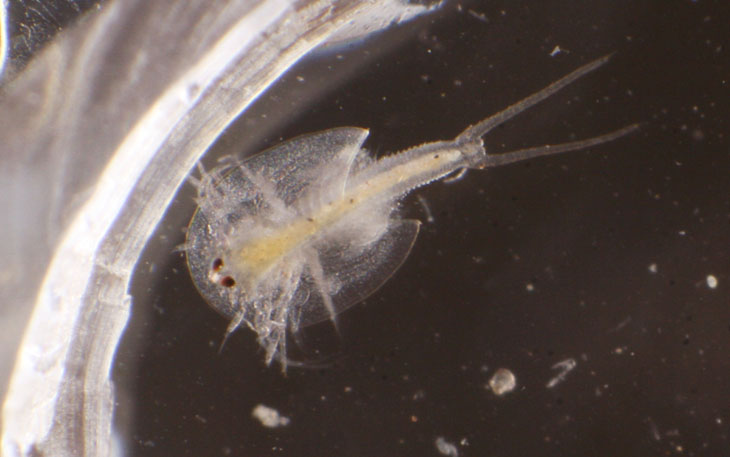
After my failed attempt to hatch them late last year, I purchased a packet of eggs online and tried again a few days ago, this time actually producing several examples of Triops – click on that link for more basic info. I have been told this is a Triops newberryi, a less-common species, the only other North American one being Triops longicaudatus. This specimen here, hyperactive enough to be exceedingly difficult to focus upon, much less obtain a nicely detailed image of, is roughly 3mm in overall length. They are capable of getting a lot bigger, 20mm or more, so keep checking back to see what happens.
Monday monochrome
 I felt like I just had to do this, for some reason…
I felt like I just had to do this, for some reason…
Now, the intention was that this would introduce a new webpage I’ve been working on. But my time this week has been scattered, and so the page isn’t ready yet. Thus, this serves as a teaser instead, a hint of things to come. I’ll be back within a few days to provide the update and the link. Remain calm.
Dogpile
A few days back, in the comments to an article regarding the really piss-poor showing of Americans in their acceptance of evolution, someone argued about the poll question which delivered these results by pointing out that the concepts of god and evolution “are not mutually exclusive.” For instance, god could have created the Universe and/or Earth, and set in motion the evolutionary processes, then left it all alone.
Of course, this isn’t the first time I’ve heard this one; the view is held by a very large percentage of people, with innumerable variations on how and when and to what extent god acted – it is probably far more accurate to say that every religious person has their own personal view of how things are supposed to have occurred, rather than believing that people in any given sect all follow the same beliefs. Yet, allowing for broad categorizations, the idea that evolution and creation are not incompatible is supported by no small number of people. Which is scary it itself, because it says so much more than it appears on the face of it.
Should someone ask you about riding the bus while wearing scuba gear, you could honestly and accurately tell them that these were not incompatible. They would of course be delighted about this, because their scuba gear must fulfill some aberrant desire in their lives – otherwise, why would they even bother asking about such a wildly irrelevant and pointless pursuit? And that’s pretty much where we are with the ‘compatible creation and evolution’ viewpoints – or, indeed, any attempt to tie together religion and science. [Professor Ceiling Cat, under the pen name of “Jerry Coyne,” has a soon-to-be-released book that tackles this subject, and I’m curious to see how similar our approaches are.]
Let’s start with, science is a method of producing not just knowledge, but functionality as well – which, really, is the entire point of knowledge, isn’t it? When Darwin proposed descent with modification, it inferred that there would be a physical catalyst for this, a method of transferring biological information from parent to offspring – it predicted the presence of DNA. The Big Bang theory predicted the presence, right now, of residual energy from an event that occurred 13.8 billion years ago. Both of these were absolutely true. Moreover, our knowledge about them and how they react is able to be used – technological and medical advances, predicting further aspects, and so on. That’s why science is so beneficial.
Religion, on the other hand, does not, and cannot, serve in any such manner. If we are to believe that god started the evolutionary process, what does this provide? How does it change evolution? What does it predict will happen? How does this differ from the idea that evolution is only a function of physical laws? In other words, how does created evolution differ from ‘just happens’ evolution? Only one of them could be True™, so how do we determine which?
All right, that’s unfair of me, I admit it. Let’s start a little simpler: what evidence do we have that points to created evolution in the first place? There must be some reason why people would believe that not only a god exists, but it at least started this process. This book, you say? Okay, sit tight, let me see what it says. Hmmmmm. You know, I’m not seeing a goddamn thing about evolution in this book at all – did I miss something? I mean, I see some really weird shit in here about where species came from, but even allowing for poetic license or metaphorical usage I can’t even tie this in with natural selection in any coherent fashion.
I’m not going to apologize for the sarcasm, because it’s well deserved. I didn’t even specify which holy book was being used, because it doesn’t matter; they’re all ridiculously wrong about evolution – as well as, let’s be frank, virtually everything else about where the planet came from and what the sun and stars are. One cannot use religion in any form to generate knowledge or promote an understanding of our world. There are some rather telling aspects of this too, like how it took thousands of years to come up with evolution when we supposedly have this great explanatory text given to us. And how once we stumbled upon it by ignoring the preconceived notions and actually paid attention to bare reality, all the churches were soooo quick to accept it and hold it up as the evidence that their books were right all along…
Yeah, there’s that sarcasm again. Because we all know what’s really at work here. When science has demonstrated, through stacks and stacks of evidence, that such scripture is dead wrong, people are still desperate to find a way to retain their core concept of a sky daddy, and may adopt whatever bastardization works to try and cram them together (while others will openly deny stark reality, mostly because their holy men told them to and they remain too feeble-minded to think on their own, much less actually have any standards of evidence.) It does not come from the explanatory power. It does not come from the usefulness and functionality of ‘creation.’ It does not come from the accuracy of the predictions – most times, no predictions can be found at all. It only comes from self-indulgence, the desperation to hang onto this cherished worldview, in total disregard of how little it works for anything.
That’s not the ugly, ridiculous part. Because the very idea of this sky daddy comes from scripture (and to no small extent, social pressures.) But to consider creationism and evolution to be compatible in any form, significant portions of this very same scripture must be disregarded wholesale. In fact, I have yet to see any religious person, anywhere, who has not purposefully selected the portions of scripture that they want to hold up as the word of god, while treating other portions as irrelevant or poetic or just plain beneath notice. Isn’t that fascinating? It must be a special skill, being able to adjudicate the veracity of the holy books so effortlessly…
Also interesting is how often the demarcations are seen, where ‘moderate’ religious folk distance themselves from ‘fundamental’ religious folk, not wishing to be seen in the same room and often defining exactly what a proper religion is – again, these special interpretive skills over scripture. It is extremely easy to unite these folk, however, by using one’s own interpretive skills to declare the entirety of scripture as irrelevant and pointless. No matter how many different aspects have been ignored by the religious, no matter how selective or creative they are in interpretation, that conclusion is simply unacceptable.
We can’t ignore the frequent argument that religion and scripture serve a purpose in providing appeasement to people, giving them a worldview that they like – that’s really why this whole compatibility issue even arises. One must ask, however, how important this indulgence really is. First off, does it actually make sense to believe in something completely unprovable and wholly inapplicable to everything we can experience, and not just believing, but making decisions based on such beliefs? How many other fantasies should we be running our lives over – not to mention the lives of others? I always had the impression this was a bad thing. I also had the impression ‘personal choice’ was this thing that isn’t intended to affect anyone else. But more importantly, I myself would really, really like to take all of the people incapable of using driving lanes and turn signals properly, and run them right off the road into a ditch – it would make me feel so much better. So let me know how important self-indulgence is, because I have errands to run this afternoon.
Yet, no matter what religious folk tell me is okay by their example, I’m still going to go with what both experience and critical thought tells me is best, which is to see the world as it is, to follow the evidence, and to put my trust in something that has demonstrated its functionality and worthiness of that trust. There might be things that I would like to be the case – for instance, that the vast majority of people put emphasis on rational consideration – but believing it just because I desire it to be true is delusional. Our brains are capable of accomplishing a lot more than that.
* * *
A few days back, the aforementioned Professor Ceiling Cat featured this video by Brian Dalton, otherwise known as Mr. Deity, and I figured I should go ahead and embed it here, because I couldn’t have said it any better myself, even though I have said quite a few aspects of this before. Anyway, here’s his take on being a ‘fundamentalist atheist.’
By the way, the tag, “The Way of the Mister,” has two meanings, one referring to his Mr. Deity skits, the other an obvious mockery of The Way of the Master, a series of inept religious apologist videos featuring Kirk Cameron and Ray “Bananas” Comfort. Interestingly, this mockery is somehow exponentially more intelligent and incisive than that which it mocks, and as a guy that grew up on Mad Magazine, I can appreciate this.
* * * *
It’s Eostre, and so I must once again feature this quiz, courtesy of David Fitzgerald for the content, and Phil Ferguson at SkepticMoney for the hosting.
8. When/Where did Jesus ascend back to heaven?
a. Jesus returns to heaven on the same day he arose, right after dinner, from a room in Jerusalem.
b. We don’t know exactly, but it’s at least 8 days after the resurrection, when the despondent apostles have gone back to being fishermen on the sea of Tiberias.
c. After his resurrection, Jesus spends at least 40 days of teaching his disciples in Jerusalem before ascending to heaven from the Mt. of Olives.
d. Jesus didn’t ascend into heaven; he met his disciples in the mountains of Galilee and told them he would be with them always.
e. We don’t really know; Luke is the only gospel writer who actually mentions the ascension.
Remember what I said about selectivity? Yeah…
For now
I’ve been a little busy with various projects, which have kept me away from blogging, as well as failing to inspire any new topics or allowing me to tackle some of the posts in draft form that have been biding their time. So, for now, a few quick images from the past week.
On an outing on Tuesday, the same one that netted the image from the previous post, the incomparable Al Bugg and I chased a few deer – which is to say, we watched quietly as two white-tailed deer (Odocoileus virginianus) foraged rather unconcernedly a short distance away from us at Gold Park in Hillsborough. They were well aware of our presence, and even a few kids drumming their scooters along the slats of the boardwalk didn’t spook them off.

For as common as they are around here, I have far fewer quality pics of deer than I think I should. Sure, I get a few from time to time, but I should have dozens of shots, lovely portraits, action shots and all that jazz in my stock – shouldn’t I? But three things seem to happen surprisingly often (with full recognition that I might not be totally objective here): either they appear when I have no camera in hand, or they appear when I have the wrong lens attached and can’t do much about it without spooking them off, or they stand there obediently in absolutely crappy shooting conditions. Like these.
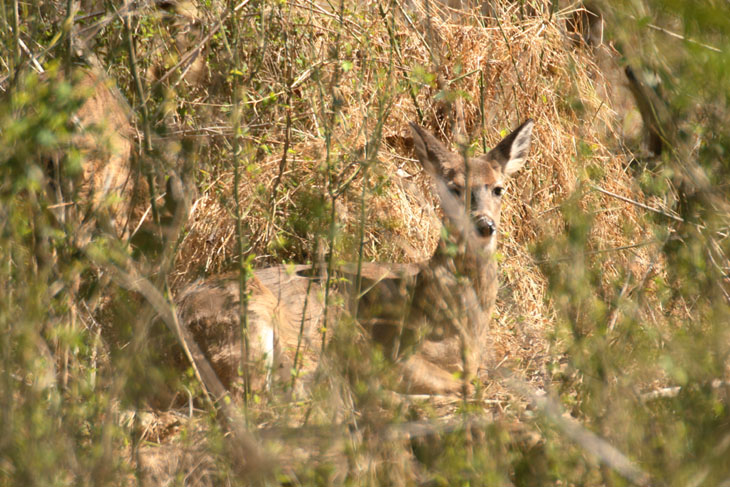
This one even lay down to bask for a bit, either cooperatively or to mock us, I’m not sure which. While I am very often using manual focus, mostly because the conditions I shoot in hamper autofocus from getting precisely what I want (and once it starts hunting, I ain’t gonna git nuffin,) there are limits to that too. With obscuring vegetation as seen here, it becomes very hard to pick a distinctive, high-contrast portion of the subject and pin that down, especially since none of the digital cameras I’ve used is geared towards manual focus, and their screens are only so distinct. Not to mention small – whenever I switch back to the film bodies I’m always delighted in how big and bright the viewfinder is in comparison. This shot seems fine for web use, but lacks the critical sharpness that I really want for my images.
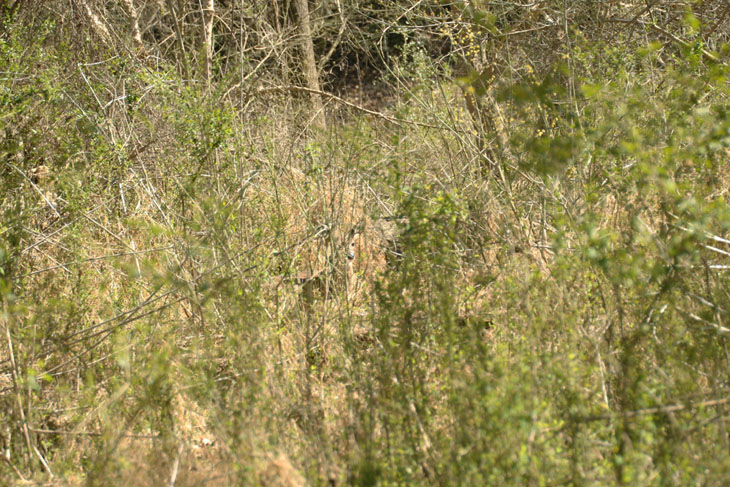
I was using the Sigma 135-400mm lens for these, and this is backed off to 135mm focal length – still magnified a bit from what one would see without a camera, but giving a little more of an impression – the distance between us and the deer was ten to twelve meters or so, and really, this was the best vantage point available. Let’s just heave a heavy sigh together here and move on.
I saw a herd of deer the following day too, in fact I walked through the middle of them, which is to say, I was walking a path when the herd was crossing, and caught the first couple on the path itself. After they spooked off, I forged ahead to try and obtain a better vantage point, and the remainder of the herd, which I was unaware were waiting in the underbrush silently, darted across the path behind me. While I have a few photos, they’re really not at all worth putting up here. Make all the snarky comments you like.

The arthropods are starting to appear, including the first damselflies I’ve seen this season, mostly visible by the glitter of their wings as they fly. I still have plans to capture the emergence of the adults, as they molt their exoskeletons from the nymph stage, since I have no detailed sequences of this yet. The nymphs live in the water, and for the final instar they climb up reeds, lock their feet in place, and molt out as sexually mature adults, unfolding and drying out their wings. I’ve caught this not long afterward, but never in process yet.
 Not far away, also on the banks of the pond, I came across this quite large cocoon, the largest I’ve ever seen – it measures a good 10 cm (4 in) in length, not quite half that in diameter, and has a lovely rough paper texture. It seems likely this is the cocoon of a silkworm moth, Hyalophora cecropia (click on the Info and Images tabs at that link for more illustrations.) Hopefully, I can get my timing right on the emergence of this one too, because that should be a lovely sequence.
Not far away, also on the banks of the pond, I came across this quite large cocoon, the largest I’ve ever seen – it measures a good 10 cm (4 in) in length, not quite half that in diameter, and has a lovely rough paper texture. It seems likely this is the cocoon of a silkworm moth, Hyalophora cecropia (click on the Info and Images tabs at that link for more illustrations.) Hopefully, I can get my timing right on the emergence of this one too, because that should be a lovely sequence.
I spotted a large water snake as well, and have a shot of its midbody while the head was hidden in the grasses, but as I maneuvered around for a better vantage, it became aware of my presence and shot off into concealment. I often find it amusing how spooky people are of snakes, believing that the reptiles are going to launch themselves to the attack if anyone gets too close, since I frequently try to get as close as I can for pics and always watch the snakes hurtle away in terror – even when provoked, they can’t manage a decent attack. Still, I understand that phobias are irrational by definition – just don’t let them dictate defensive or abusive behavior.
I close with a six-spotted tiger beetle (Cicindela sexguttata,) a brilliant iridescent green species fairly common around here, hyperactive and sometimes hard to approach. A little patience allowed me to capture this portrait showing off those great predator’s mandibles. Also note that the eyes are actually shaped to give the appearance of glaring, instead of simply round, which to humans seems to indicate menace. It is, of course, just a physical trait on a visage that can’t change at all, but we can still appreciate the impression.
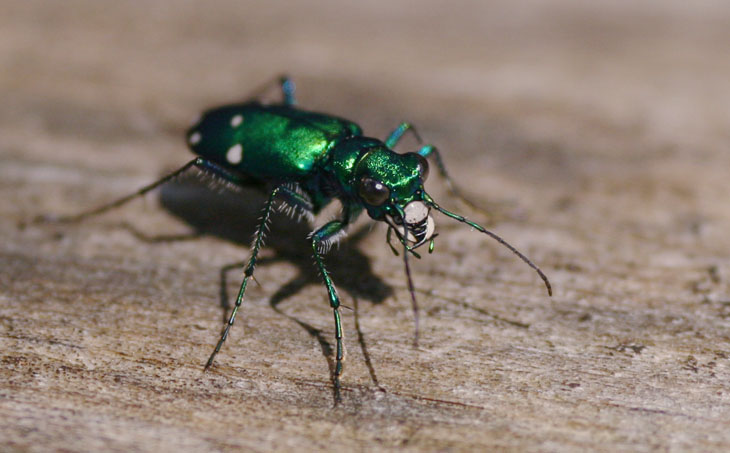
And, truth be told, tiger beetles are pretty aggressive – to other insects which it considers prey, anyway. I imagine that you might provoke a noticeable pinch if you grabbed one, too, but that’s only if you were lucky (?) enough to snag it before it flew away. From numerous attempts just to photograph them, I’d say you’d have a hard time accomplishing it. But don’t let me stop you from trying…
Whoa

This is one from today that I just had to toss up here quickly. This is not a composite, or Photoshop job, or anything of the sort, but straight out of the camera. Almost, anyway – I did a slight color tweak; sue me. But I honestly wasn’t expecting results quite like this.
Here’s what you’re looking at. These tiny bluet flowers (Houstonia caerulea) were growing from a mossy bank right on the edge of a river. Shooting with the Mamiya 80mm macro wide open at f4, the depth-of-field was very short, resulting in everything but the specific blossoms that I’d focused upon to be out of focus. In the background, the sun was reflecting off of the water rippling past some rocks. Each of these sparkles is rendered into a vague circle by being very far out of focus against a dark background, in this case the bottom of the river, while the other flowers and stems and such, a bit closer, get rendered in varying degrees of softness. This page might help explain the optical aspect of it slightly better.
Whatever. I gotta admit I like it a lot. It also serves to illustrate why shooting position can be so important. There was a very narrow angle that captured the sunlight reflecting from the ripples, and half-a-meter in any direction would not have produced this effect. So, yeah…
Monday color 9

There are a few photographers that are doing this technique now, which not only requires high magnification, it demands a pretty specific layout, the water droplets having to be positioned just right near a distinctive subject (usually a flower blossom.) Only, it’s pretty rare to find something that can suspend a near-globular water drop at the right height to capture a flower behind, and I’ve suspected an awful lot of those images are carefully staged, rather than found. Nevertheless, this one was, indeed, found exactly like this, requiring only the addition of some strong light. Early one morning the mist/dew had liberally coated everything with fine drops, and while looking for interesting uses for these conditions, I spotted the wild strawberry. This was shot while lying flat on my side, lens nestled between other stalks of the weeds nearby, the strawberry providing this tiny patch of red about a centimeter wide among all the greenery, just above ground level. I’m pleased with how it all worked.
Can’t ya understand plain English?
Some time back, The Girlfriend was delighted to find a stuffed toy version of a blue-footed booby, and who can blame her? Everyone should have one, and I know if I had possessed one while growing up instead of a neon-orange-and-white velveteen rabbit, I would be a different person today. I’ll just leave that hanging out there…
 Around christmastime, somehow, it got one of those self-sticking gift bows attached to its hind end – you’re free to speculate. I figured it for an act of vandalism myself, and demanded to know the culprit responsible:
Around christmastime, somehow, it got one of those self-sticking gift bows attached to its hind end – you’re free to speculate. I figured it for an act of vandalism myself, and demanded to know the culprit responsible:
“Who put the bow on the butt of the booby?”
Such a simple, direct question – I don’t know why I had to ask it three times…
[Little Girl really did photobomb the frame as I was getting the shot – I only take credit for capturing it as it occurred.]
You can hide, but you can’t run

Actually, you can run if you want, and you may, because the image above is the least icky – it’s all downhill from here. You should know I don’t say that lightly…
What you’re seeing here is the larva of a green lacewing fly, family Chrysopidae, bearing the typical camouflage for this time of year, which is a nice coat of lichen – the background surface is my palm, to give a faint sense of scale. This variety of lacewing has a set of extra appendages along its back, little tree-like structures, to which it can attach things to hide its true nature from predators – I’ve seen them covered with chaff, and molted exoskeletons of other species, and once even a dead ant (very punk, that one,) but none of that is available right now, so it’s lichen. Lichen, however, is not particularly ambulatory, nor does it grow in neat little patches like this, so the species is not hard to find if you’re so inclined, and I sought out this particular one for the illustration.

Here’s a peek behind the curtain; the head is to the right, and you can see its long, reddish-brown chelicerae, with a small cluster of eyes near the base and some of the striping on the head – remember this, because you’ll need it to identify something in just a second. The real meat of the post is the tableaux I spotted last night, realizing what I was seeing and trotting in to get the camera. Yes, we’re off on the whole spider thing again – I don’t try to do this, I really don’t, but they’re what I spot most often.
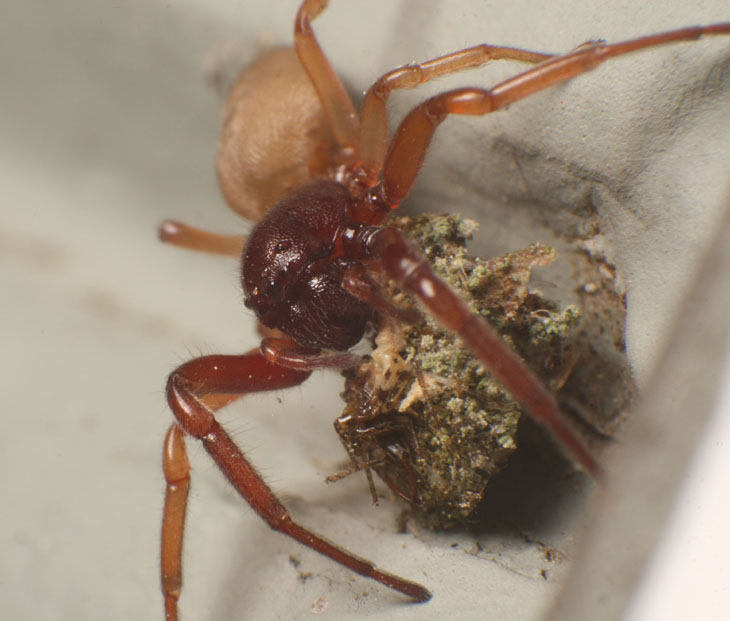
The camouflage only works so well, and it’s largely a visual thing, which doesn’t always work on anything that hunts by something other than sight. Near as I can determine, this is a species of ground spider, family Gnaphosidae, and its lacewing prey is sitting belly-up, head at lower left. The chelicerae are pointing almost straight down, with the forelegs bunched under the ‘chin.’ But naaah, that’s not close enough, so let’s get a slightly better view.
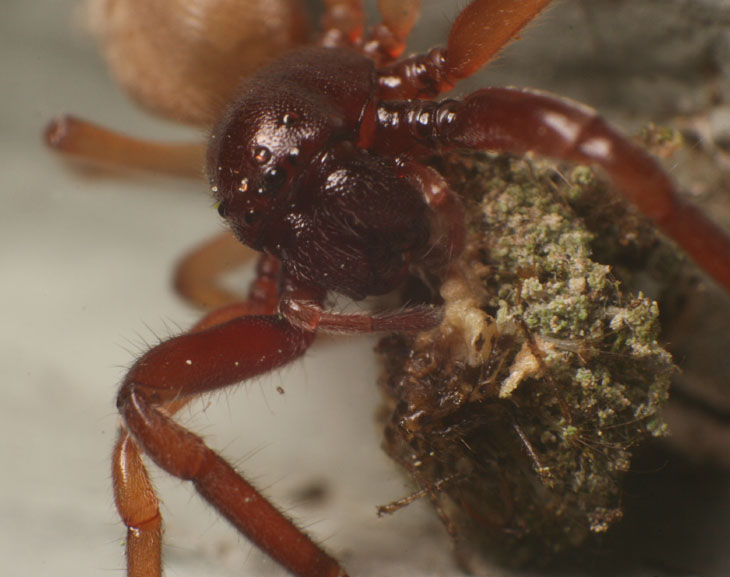
This is a nice illustration of the spider’s eye pattern, which is one of the more dependable ways of identifying spiders, with a bit of reflection from the two at top center, and the faintest hint of the spider’s own chelicerae can be seen just under that walrus mustache. The mustache is misleading, however, since this is a female. What can also be seen, with a close examination, are two of the appendages that the lacewing attaches its camouflage to – find the dark straight line of one of its forelegs, stretching across the lichen to the right, and you can see the little arms at either end of the leg segment, ends splitting into very fine branches. If I’d witnessed the capture, I might have been able to tell you how the spider knew it was a meal, but all I saw was this, so I’m just going to guess it was movement that triggered the capture.
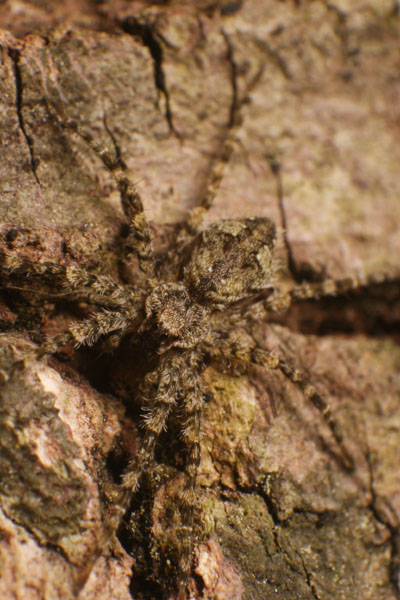 Last night was quite warm as a front pushed in, so I was prowling around to see what could be found. This one is probably a wolf spider (family Lycosidae,) with a slim possibility of being a wandering spider (family Ctenidae) – I can’t see the eye pattern well enough in any of the frames I took, but there’s only a handful of species of the latter and scads of the former, so I’m favoring wolf right now. The camouflage against the tree bark was great, and I’m not even sure how I spotted this one, but it might have been because it moved. With legs fully spread it could still sit on your thumbnail without overlap, so not exactly an imposing specimen.
Last night was quite warm as a front pushed in, so I was prowling around to see what could be found. This one is probably a wolf spider (family Lycosidae,) with a slim possibility of being a wandering spider (family Ctenidae) – I can’t see the eye pattern well enough in any of the frames I took, but there’s only a handful of species of the latter and scads of the former, so I’m favoring wolf right now. The camouflage against the tree bark was great, and I’m not even sure how I spotted this one, but it might have been because it moved. With legs fully spread it could still sit on your thumbnail without overlap, so not exactly an imposing specimen.
The headlamp was turning up the occasional blue star reflection on the ground indicating spiders, but they were exceptionally shy, I’m guessing from it still being early in the season, and I could never get close to any. It’s a shame, because they were all much bigger than this one and would have made for much creepier images – hey, if I’m gonna do it, I might as well go whole hog, right? But don’t fret – there’s still plenty of time. In fact, I might have obtained a new way to step up my Creepy Game, but I’m not sure yet and don’t want to get you all excited for nothing.

Yet another small one, but this one was captured and photographed in ‘studio’ conditions, so while doing that I was able to get specific measurements as it obligingly held quite still in this position – it’s 13mm in length overall, from leg tip to leg tip, but only 3mm in body length. I believe this to be a longlegged sac spider species, family Cheiracanthium, but again, not sure. I’ve tried asking them but they all remain silent, waiting on their attorneys no doubt. But yes, one of those eyes produced a reflection from the flash.
 And another view, because I could – I like the legs stretching towards the corners and going well out of focus, and I’m wondering if it produces an ominous, reaching-for-you feel to anyone out there. One of these days I’ll try to produce a ‘stacked’ image getting the whole thing in focus, by shooting a series of images focused at different points along the body and stitching them together, but that will be a serious staging issue and I’m not sure how much it’s really worth it. The easiest way would be to have a sliding stage that the subject sits upon, since tracking focus/zoom at this magnification is difficult – the lens action is too sticky, meaning the camera can be jiggled easily from its position, even on a tight tripod. Something nice and smooth in operation like a microscope stage would be ideal, but I have yet to run across one of those to scavenge for stuff like this.
And another view, because I could – I like the legs stretching towards the corners and going well out of focus, and I’m wondering if it produces an ominous, reaching-for-you feel to anyone out there. One of these days I’ll try to produce a ‘stacked’ image getting the whole thing in focus, by shooting a series of images focused at different points along the body and stitching them together, but that will be a serious staging issue and I’m not sure how much it’s really worth it. The easiest way would be to have a sliding stage that the subject sits upon, since tracking focus/zoom at this magnification is difficult – the lens action is too sticky, meaning the camera can be jiggled easily from its position, even on a tight tripod. Something nice and smooth in operation like a microscope stage would be ideal, but I have yet to run across one of those to scavenge for stuff like this.
Anyway, there’s your spider fix. I’m still watching for any other subjects, but it seems I’m destined to find mostly arachnids. It’s probably something karmic.
But how? Part 17: god’s plan
[EDIT 4:30 PM: This post went through numerous drafts over a period of days, which means it was in process long before this little squirt of utter bullshit came out, and I managed to post it before Jerry Coyne posted his commentary – once again, I hate looking like I’m copying or springboarding from someone when I’m not (and happy to give them credit when I am.) But yeah, very topical, and illustrative of the same issues I talk about below.]
You can blame the previous installment for suggesting the topic this time around, but it’s a common concept within religious apologetics regardless, so it deserves the critical examination. I’ll be right up front with this: I consider the claim of anything at all being “god’s plan” a cop-out, pure and simple, an excuse to dodge the inherent flaws and inconsistencies in a religious worldview. However, disliking a concept (or, alternately, liking it) isn’t a solid reason to pass judgment on it, so let’s take a close look at all of the ramifications of “god’s plan.”
The structure of most of the ‘But how?‘ posts has been to explain how a universe without any deity can function just fine, and how so many of the factors or traits ascribed to such are just as easily, if not more so, explained without any such supernatural influence. In this case, however, there will be nothing to fill in or alternately explain the traits attributed to a master plan, since such arguments have no traits to begin with – the master plan is always assumed to be an unfathomable thing, an explanation unto itself when the logical flaws in religion appear. The naturalistic world displays no evidence whatsoever of a plan, nor does it present any reason why we should invoke or seek one. That so many people find this a disagreeable or contentious conclusion is a strong indication that motives and desires should be examined carefully in such topics, because wanting it to be true is enough to cause significant bias and a lack of objectivity, especially when it comes to producing philosophical/theological arguments. Sophistry is very easy to accomplish, and goes unnoticed as long as someone finds the conclusions so gratifying that they don’t bother to examine them critically – quit while you’re ahead, in other words. Yet there are actually so many flaws in the concept of a master plan that it’s amazing it still exists, much less getting used with such frequency and confidence.
To begin with, if we accept the premise of a omniscient, omnipotent being, there actually can be no such thing as a plan of any kind. Any being that knows everything cannot plan to do something, since the results are already known, and thus all it can do is follow the script. Planning is a concept that requires uncertainty about the future, and the desire to produce a preferred outcome among many options. We cannot, for instance, plan on gravity taking effect only at a certain time, since it’s going to whether we like it or not, nor can we plan for a book that we’re reading to end a certain way.
There is also the failure when compared against omnipotence, as well. Any being that can do anything and everything does not need to plan – any such desired outcome can be produced instantaneously. So even given an uncertainty about the future, plans are still a pointless aspect of a omnipowerful being. And in fact, the passage of time becomes pointless and meaningless as well – why should there be any such thing as a ‘future’ when anything can happen immediately? This also trashes the claims that such supreme beings live ‘outside of time’ or all throughout it or whatever. Obviously, nobody’s been thinking these things through in the slightest.
But okay, let’s go ahead and bend the rules a little, and posit that the properties we have been assured of for centuries don’t actually exist; this supernatural being is instead very powerful and very intelligent, but not ultimately so, being limited on both fronts. It is also trapped in the passage of time as much as we are. Thus, the future is actually uncertain, and not everything can be achieved immediately. We still have to face the third necessity of planning, and that’s a desire for a certain outcome. Which by itself is a really loaded avenue of thought. Nearly all of our human desires are easily traced back to survival, whether related to procreation, or status, or even just figuring out mysteries – the ability to find solutions to puzzles has been responsible for accomplishments as basic as figuring out how to plant crops and as advanced as calculating mass, velocity, and gravitational influence to maintain satellites in orbit. Natural selection can account for these easily, and the ones that haven’t (so far) been adequately plumbed by this theory – things like the appeal of thrill rides or the purpose of nostalgia – aren’t really leading in a religious direction anyway. But what desires would a supernatural being possess, and where would they come from? Survival, social instincts, avoiding danger, even any form of accomplishment – all meaningless to such an existence. All of our frames of reference are from the standpoint of humans whose existence is not guaranteed, and who must compete, beings with finite abilities and lifespans no matter what. We cannot even say that anything supernatural could get bored, or has thinking processes at all, much less something bearing any resemblance at all to our own. In fact, it is safe to say that perpetual existence is something that would be pretty damaging to the makeup of our own minds, so any being that could handle this is not very likely to be similar in any way.

Which means that the appeal of a master plan can only come with a lot of bare assumptions, ones that we have no evidence of and no reason to believe are valid. Even the tautological assurance that scripture is true because scripture tells us it’s true fails to take into account the simple possibility that misdirection is part of the game. Whose game, of course, is a question that remains to be answered, but I’m quite sure that the first thing I’d do when trying to mislead someone is assure them that I’m legit, and I doubt this insight was lost on all of the people who were scribbling down scripture throughout the centuries. Nobody has even come close to ruling out the possibility that scripture is simply creative fiction, while two distinctive traits make the probability of this high enough not to be ignored (unless, ahem, you’re trying): the bare fact that there are other religions in the world, which obviously cannot all be right despite having their own self-confirming scripture; and the uncomfortable evidence of the extensive editing that has taken place over the centuries. But it gets even worse.
Whenever someone insists that everything is part of a master plan that we aren’t meant to know, the very first question to pose is, “Then how do you know about it?” Let’s be real, here: if we can be created by some being, then that same being can just as easily a) tell us what it’s all about, or b) completely eradicate the very idea of questioning to begin with. This idea that we have some information regarding what we’re involved in but, ha ha, “I can’t tell you,” goes beyond pointless. There are two scenarios that make it past the logic failure: the first is that it’s all a game of this supreme being with no intention of making sense or reaching a particular conclusion – which not only defeats the definition of ‘plan,’ it eradicates any reason to care about it in the slightest – and the second is if doubt and uncertainty are specific functions that we’re supposed to have. Which is fine – let’s run with that posit too. Think about everything in our lives that we doubt, and what uncertainty does for us, why we even have it. Does it revolve around, to a significant margin, danger and survival and erring on the safe side? Does the uncertainty that there might be a speeding car coming around the bend, or that the fish being sold from the back of a van might not be the healthiest thing we’ve ever eaten, demonstrate the functions of doubt well enough? Does the presence of umpteen-hundred laws regarding consumer safety and contractual obligations tell us that doubt is misguided or frivolous? If anyone wants to argue that doubt is part of the plan, that’s fine – the first thing to doubt is the claim that there’s a plan in the first place.
But let’s not leave that one hanging all alone. Note that, in the vast majority of cases, the idea of a plan is used not to clarify anything, but to excuse the discrepancies, the anachronisms, and the contradictions that continue to crop up in religions worldwide. In almost every usage, the phrase is intended to stop us from questioning and doubting. It slots into the huge open space left in our concepts of religion when reality isn’t demonstrating any of the properties that this god and its creation are supposed to have. Theodicy is the (quite large) branch of theology that tries to cope with the very existence of evil in a created universe, and untold years have been spent on this pursuit – yet, this is only because of the overriding assumptions that there is both a beneficent deity and a plan. The problem is solved by assuming a deity that is not beneficent, as well as being solved by no plan at all – and it must be said that evil almost becomes a non-issue from an atheistic standpoint, because it is no longer a defined aspect that must have been created or intended, but simply an artifact of a competitive species (and not particularly hard to trace back to survival instincts, as well.) No more part of a plan than a sex drive or the ability to taste food.
If, instead of simply using it as an excuse when things aren’t making sense (such as the countless contradictions throughout scripture,) we instead apply this idea of a plan throughout, we have to accept that we are only puppets, in many cases doomed to ignominious ends precisely because the rules have been withheld from us – the plan obviously being far more important than the entirety of life on this planet. Pick any scripture that you like, and recognize that with the concept of a plan, every death, every torture, every abuse, all suffering, was intended – again, this is the problem of theodicy. For instance, if we take the creation story from the abrahamic scriptures, we have to reconcile the plan against the ‘fall,’ and the expulsion of adam & eve from eden, making the issue of punishment for their behavior, in fact the behavior itself, a script. Scripts are fine for fiction, but it’s quite a different matter when it’s our lives that are playing the parts. All of the things we were supposedly created to feel, love and pain and camaraderie and the desire for a strong society – everything – are all play-acting in denial of the control that the supreme being wields over our lives. We were created to find these immensely important, but then told they really don’t matter at all. Did you sweat blood over raising that child, born with a disability, to face life optimistically and with a fine sense of ethics? Too bad – she’s going to die at age 17 in service of this master plan. Bear in mind, once again referring to the abrahamic scriptures, that this supposedly happened to every single being on the planet, save for the select few on the ark. How, exactly, did the centuries of life leading up to that event perform some function? Are we to believe that all of god’s petulant hissy fits that resulted in mass slaughters, throughout any religion one cares to name, were all planned? Is this idea somehow comforting to all those who promote it? Or do they ignore the ramifications?
The argument can be made that this concept of an ultimate goal means we all play a part, and no matter how pathetic our lives or ends, it serves to push this goal along. Sounds fine on the face of it – until you recognize that we were created to suffer, and could just as easily have been created not to. And again, this is assuming that it’s a worthwhile plan, and not because some god is simply bored. Going a little deeper, it is the definition of nihilism; it doesn’t matter what we do because our actions are through ignorance of the true goal – we cannot act to shape it without knowing what it is.
Going still deeper, it has served as justification for virtually any action that religious folk have taken, no matter how heinous (and there’s been a hell of a lot) – obviously mere mortal desires and comfort must take a backseat to this plan, and since god has it all under control then whatever happens is obviously a part of it, right? This might even sound good when it’s used in conjunction with whatever actions we feel like taking, but it pales a bit when it comes to watching our village get decimated, or when the bomb rips apart the bus. Seriously, in the face of this master plan, what does any action, any feeling, any desire, matter?
But again, these desires do have a specific benefit to an evolved species, requiring no philosophical gymnastics to try and explain or excuse. Even the idea that organized religions are all just the efforts of a self-absorbed few to consolidate their power structure – which no one has disproved in the slightest – fits in quite well with evolved traits. It does mean, however, that we are responsible for our own decisions, and answerable not to what we imagine some supreme being really meant, but to all of those around us instead. We have the ability to foresee and predict the consequences of a large percentage of our actions, and we have reached the level that we now occupy precisely because this ability is so remarkably useful, making it both functional and explanatory, not to mention an overriding drive of humanity. To discard all of that, to dismiss all accomplishments of mankind throughout history, in favor of a shallow, feeble attempt to excuse all of the logical failures and anachronisms of religion, is undeniably pathetic. We can do better.
Hey, Vernal!

If I’d been more on top of things, I could have posted this the day I took it, which was Saturday, and thus only been a day later than the equinox and slightly more, I dunno, appropriate? Timely? Whatever, this is a nice illustration of spring, better than I originally believed, even. I think it’s fairly obvious how narrow a field of view this is, capturing a tiny section of a shallow pond, and I was focusing on the minnows over the leaf. However, I count eleven separate critters or portions thereof present in the frame. If you get more than that, let me know, and I’ll give you a prize of some kind once our independent judges have confirmed the count.
 Aw, what the hell, here’s another, a pond slider showing off those fabulous nails. I did a tweak in the curves function in Photoshop to bring out the stripes on the head and hind a little better, rendering it slightly less of a silhouette. This is a tighter crop than the original, and it’s interesting the difference it can make – there were no more reeds visible in the wider version, but additional open water in the lower corners, so this crop makes it seem more as if I was spotting the turtle through a gap in a thicket of weeds than the original does. I think our minds, knowing how plants grow, automatically fill in the lower sections outside of the frame with the reeds that must be there. And until I saw the effect for myself, I never would have imagined it working that way, so playing around with exactly how and where you crop an image might bring out a different perspective and impression. Experiment freely.
Aw, what the hell, here’s another, a pond slider showing off those fabulous nails. I did a tweak in the curves function in Photoshop to bring out the stripes on the head and hind a little better, rendering it slightly less of a silhouette. This is a tighter crop than the original, and it’s interesting the difference it can make – there were no more reeds visible in the wider version, but additional open water in the lower corners, so this crop makes it seem more as if I was spotting the turtle through a gap in a thicket of weeds than the original does. I think our minds, knowing how plants grow, automatically fill in the lower sections outside of the frame with the reeds that must be there. And until I saw the effect for myself, I never would have imagined it working that way, so playing around with exactly how and where you crop an image might bring out a different perspective and impression. Experiment freely.




















































